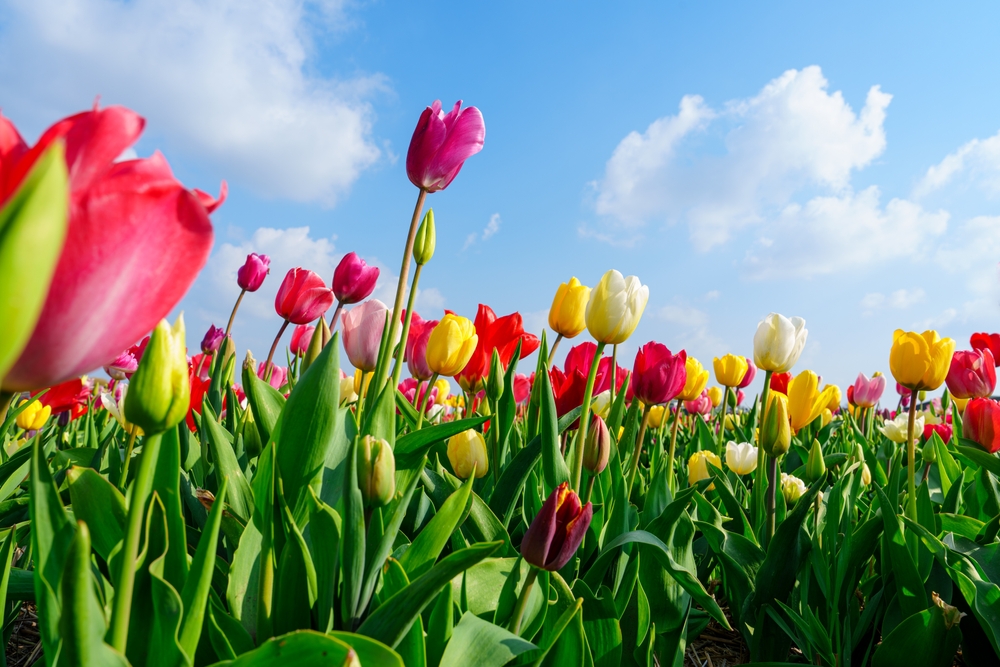
Image Source: Shutterstock.com
Tulips are one of those flowers that can make any garden feel like a fairytale. Their bright, cheerful colors seem almost magical after a long, drab winter, but getting them to bloom requires a little more strategy than simply sticking bulbs in the ground. Many gardeners assume tulips should be planted in early spring when the weather warms up, but that’s actually too late.
Tulips are a cold-weather kind of flower; they need a chilling period to awaken properly and produce those iconic blooms. Understanding the timing—and why the cold is your friend—can turn your spring garden from average to spectacular.
Why Tulips Love The Cold
Tulips are hardy flowers that have evolved to thrive in climates with cold winters and cool springs. Their bulbs require a period of chilling to trigger the chemical changes that prompt flowering. Without this cold exposure, tulips may sprout weakly, bloom late, or sometimes not bloom at all. This chilling period mimics the conditions they would experience in their native regions of Central Asia and parts of Europe. So, ironically, the colder you plant them—within reason—the better their spring performance will be.
The science behind this is fascinating. When a tulip bulb experiences cold temperatures, it undergoes a process called vernalization. This transforms its internal structures, preparing it to produce strong shoots and vibrant flowers when the soil warms. If you try planting bulbs in mild temperatures or wait too long into spring, the vernalization process may be incomplete. That means disappointing stems, droopy leaves, and fewer blooms. Understanding that tulips need a cold “wake-up call” changes the way we approach planting entirely.
When Exactly Should You Plant Tulip Bulbs
While the idea of planting in freezing conditions may sound counterintuitive, timing is everything. For most regions in the northern hemisphere, late fall is the perfect window. Soil temperatures should generally be below 60°F, ideally around 50°F or cooler, to ensure proper chilling. This usually means planting bulbs before the ground freezes solid but after the soil has cooled from summer heat. Planting too early risks rot if the soil remains too warm, while planting too late can prevent bulbs from establishing roots before winter.
In areas with milder winters, gardeners may need to refrigerate bulbs for several weeks before planting to simulate cold conditions. Conversely, regions with harsh winters may require slightly earlier planting to prevent bulbs from freezing above ground. Local climate and weather trends matter more than the calendar alone. Observing your soil temperature, rather than just the month, ensures your tulips get the proper cold treatment they need. With the right timing, your tulip garden will reward you with strong, healthy, and colorful blooms.
How To Prepare Your Garden For Cold Weather Planting
Planting tulips in colder months requires a bit of planning to give bulbs the best chance at survival. Start by choosing a well-draining location; tulip bulbs hate standing water, especially during freezing temperatures. Loosen the soil and enrich it with compost or other organic matter to provide nutrients for the roots as they develop. Avoid planting in areas prone to frost pockets or soggy soil, as this can lead to rot and decay. Finally, arrange bulbs with enough space between them to allow air circulation and avoid overcrowding.
Mulching is also a crucial step. A layer of straw, leaves, or wood chips insulates the bulbs and regulates soil temperature. This protects against extreme cold swings and helps maintain moisture levels without oversaturating the soil. Mulching also delays early sprouting caused by unseasonably warm days in winter. By preparing your garden carefully, you’re giving your tulips a cozy, protected start that encourages strong growth come spring.
Choosing The Right Tulip Bulbs
Not all tulip bulbs are created equal, and selecting the right variety can influence how well they respond to cold planting. Some types, like Darwin hybrids or Triumph tulips, are particularly resilient and reliable under varied winter conditions. Others, like parrot or lily-flowered tulips, are more delicate and may need extra care to survive extreme cold. Pay attention to bulb size as well; larger bulbs generally produce bigger, more vibrant blooms. High-quality bulbs with no signs of mold or soft spots are essential for successful planting.
Buying bulbs from reputable sources ensures they’ve been properly stored and handled before planting. Poorly stored bulbs may be dry, shriveled, or damaged, which drastically reduces the chances of flowering. Inspect bulbs before planting and discard any that look compromised. With strong, healthy bulbs, your chilly efforts will pay off with a breathtaking display of color in spring.

Image Source: Shutterstock.com
Planting Depth and Spacing Matters
Planting tulips isn’t just about sticking them in the ground; depth and spacing play a huge role in their success. A general rule of thumb is to plant bulbs two to three times as deep as their height. This protects the bulbs from frost and helps anchor strong stems. Spacing between bulbs should be around four to six inches to allow room for growth and airflow, which reduces the risk of disease. Following these guidelines helps tulips establish a strong root system before winter fully sets in.
Bulbs planted too shallow may freeze or dry out during the cold months, while those planted too deep may struggle to emerge in spring. Proper depth also affects how tall and sturdy the flower stems will be. Meanwhile, spacing prevents overcrowding, which can lead to competition for nutrients and water. Paying attention to these details ensures a beautiful, uniform garden once the tulips bloom.
Caring For Tulips After Planting
Once your bulbs are in the ground, it’s tempting to forget about them until spring, but a little attention now pays off later. Water lightly after planting to settle the soil, but don’t oversaturate; tulip bulbs do not like soggy conditions. Keep the mulch in place to maintain consistent temperature and moisture levels. Avoid fertilizing in the fall; tulips do better with a slow-release fertilizer in early spring as growth resumes. Finally, resist the urge to peek too often—disturbing the soil can damage delicate roots.
The magic happens under the surface as the bulbs develop roots and adapt to cold temperatures. By the time the weather starts to warm, tulips are ready to break dormancy and push up bright, healthy shoots. Your patience in the cold months will result in one of the most rewarding experiences in gardening. When those first blooms appear, it’s hard not to feel like a horticultural wizard.
Timing Is Everything
Tulips are deceptively simple flowers, but getting them to bloom beautifully requires respecting their natural rhythm. Cold weather isn’t your enemy—it’s the signal that tells bulbs when to wake up and thrive. Planting at the right time, choosing healthy bulbs, and preparing your garden carefully ensures a spectacular spring display.
Have you planted tulips in winter before, or are you trying it for the first time? Make sure that you share your tips, experiences, or unexpected garden successes in the comments section for others to learn.
You May Also Like…
How Autumn Pollinators Choose Their Flowers
Why Bees Seek Late-Blooming Flowers in Autumn
The Garlic Planting Trick Most Gardeners Don’t Know
7 Flowers That Self-Seed and Return Next Spring
6 Cold Weather Herbs That Keep Producing Indoors
Leave a Reply